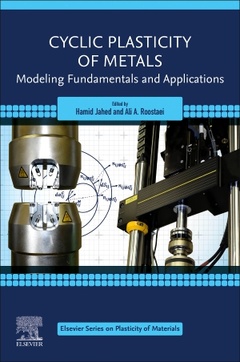Cyclic Plasticity of Metals Modeling Fundamentals and Applications Elsevier Series on Plasticity of Materials Series
Coordonnateurs : Jahed Hamid, Roostaei Ali A. A.

Cyclic Plasticity of Metals: Modeling Fundamentals and Applications provides an exhaustive overview of the fundamentals and applications of various cyclic plasticity models including forming and spring back, notch analysis, fatigue life prediction, and more. Covering metals with an array of different structures, such as hexagonal close packed (HCP), face centered cubic (FCC), and body centered cubic (BCC), the book starts with an introduction to experimental macroscopic and microscopic observations of cyclic plasticity and then segues into a discussion of the fundamentals of the different cyclic plasticity models, covering topics such as kinematics, stress and strain tensors, elasticity, plastic flow rule, and an array of other concepts. A review of the available models follows, and the book concludes with chapters covering finite element implementation and industrial applications of the various models.
Part One: Introduction 1 Experimental observations in cyclic loading of metals 2 Fundamentals of cyclic plasticity models
Part Two: Cyclic plasticity models 3 Multisurface cyclic plasticity 4 Two-surface cyclic plasticity 5 Nonlinear kinematic hardening cyclic plasticity 6 Distortional hardening cyclic plasticity 7 Computational methods for cyclic plasticity
Part Three: Applications of cyclic plasticity 8 Cyclic plasticity applied to the notch analysis of metals 9 Application of cyclic plasticity for modeling ratcheting in metals 10 Application of cyclic plasticity to fatigue modeling 11 Cyclic plasticity of additively manufactured metals
Dr. Jahed is a renowned researcher in the fields of plasticity, cyclic plasticity, continuum mechanics, and durability of metals under cyclic loads. He has over 200 scientific publications and has trained more than 75 PDF, PhD, and MASc students in these fields. Working closely with various industries, especially automotive, he has developed a number of cyclic plasticity-based fatigue life prediction models with direct application to design of structural parts in the transportation industry. He has been teaching different subjects in his research field to over 4000 undergraduate and graduate students over the past twenty years and has received a number of teaching awards including the Sandford Fleming Teaching Excellence Award.
Postdoctoral Fellow, Mechanical and Mechatronics Engineering Department, University of Waterloo.
Dr. Roostaei works in the field of cyclic plasticity of metals, specifically magnesium alloys. He has developed a new cyclic plasticity model applicable to wrought magnesium alloys, which exhibit unusual plastic flow characteristics under cyclic conditions. During the model development process he completed a comprehensive review of these models into numerical code for the purpose of comparing the results of his model in similar loading cases. He has published over a dozen articles in peer-reviewed internationally renowned journals.
- Reviews constitutive cyclic plasticity models for various metals and alloys with different cell structures (cubic, hexagonal, and more), allowing for more accurate evaluation of a component’s performance under loading
- Provides real-world industrial context by demonstrating applications of cyclic plasticity models in the analysis of engineering components
- Overview of latest models allows researchers to extend available models or develop new ones for analysis of an array of metals under more complex loading conditions
Date de parution : 11-2021
Ouvrage de 468 p.
15.2x22.8 cm
Thème de Cyclic Plasticity of Metals :
Mots-clés :
3D print; Additive manufacturing; Anisotropy; Bauschinger phenomenon; Besseling plasticity; Bounding surface; Constitutive model; Critical plane; Cyclic hardening/softening; Cyclic hysteresis loop; Cyclic plasticity; Cyclic plasticity models; Damage accumulation; Deformation micromechanisms; Digital image correlation; Directional distortion; Directional distortional hardening; Direction-dependent properties; Distortion; Energy-based approach; Fatigue damage; Fatigue life estimation; Finite element analysis; Isotropic–kinematic hardening; Kinematic hardening; Low cycle fatigue; Low-cycle fatigue; Masing behavior; Metallic materials and components; Mroz plasticity; Multiaxial; Multisurface plasticity; Nonproportional hardening; Ratcheting; Segmented yield function; SS316L; Strain-based approach; Ti-6Al-4V; Uniaxial/multiaxial loading; Work hardening moduli field; Yield surface shape



